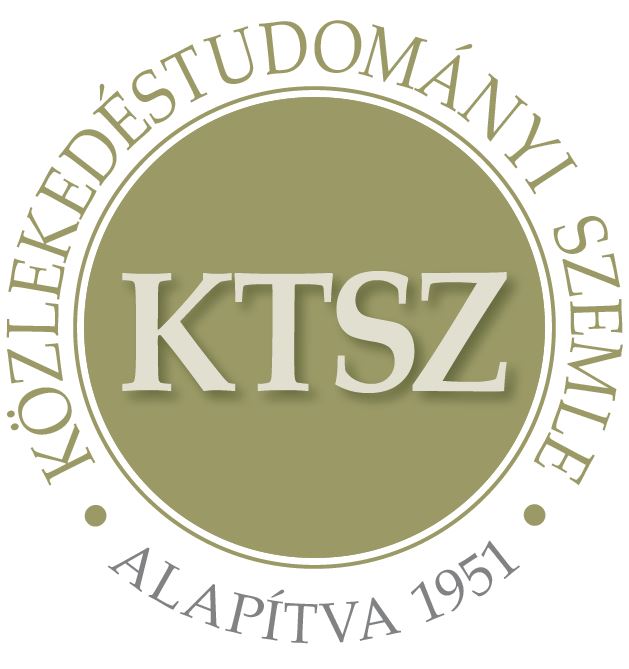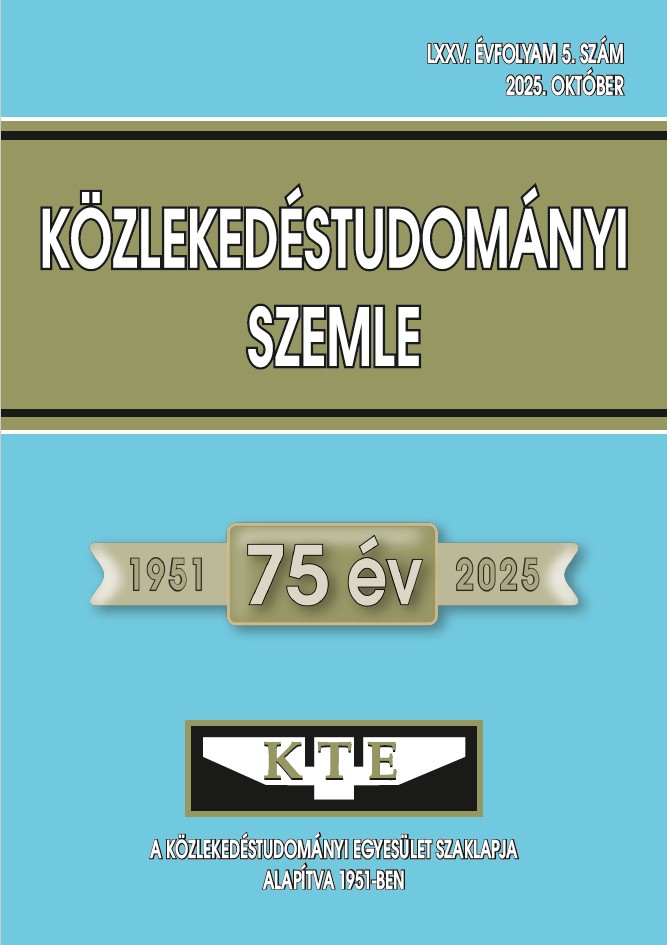The Impact of Centrality in Public Transport Networks
Abstract
Transport networks play a key role in the development of urban areas, influencing their importance and structure. In this study, we assessed centrality in Budapest by examining the public transport network. We analysed network centrality indicators using closeness, betweenness, straightness, and degree centrality. By combining the indicators, we identified areas with high centrality and potential future centers. For a broader structural perspective, we also calculated the average centrality levels for each district. From a methodological perspective, this research provides a new approach applicable to any city. In the context of Budapest, it offers practical results for urban planning and mobility development.
References
U., Rydningen, R. C., Høynes, L. W., Kolltveit (2019) ‘OSLO 2019: A CAR-FREE CITY CENTRE’, presented at the Sustainable Development and Planning IX, Bristol, UK, Jun. 2017, 3–16. DOI: https://doi.org/10.2495/SDP170011
C., Macharis, I., Keseru (2018) Rethinking mobility for a human city, Transport Reviews, 38(3), 275–278, DOI: https://doi.org/10.1080/01441647.2018.1423612
X., Dou, M., Jian, C., Guo, J., Cao (2023) Estimation of the aggregation degree of public transport use among elderly people based on urban built environment. Journal of Transport Geography, 112, 103707, DOI: https://doi.org/10.1016/j.jtrangeo.2023.103707
G., Giuliano, K. A., Small (1993) Is the Journey to Work Explained by Urban Structure?, Urban Studies, 30(9), 1485–1500,
W., Alonso (1964) Location and Land Use: Toward a General Theory of Land Rent. Joint Center for Urban Studies of the Massachusetts Institute of Technology and Harvard University. DOI: https://doi.org/10.4159/harvard.9780674730854
V. V., Natalia, D., Heinrichs (2019) How to Define Urban Centres: Concepts Overview and Propose Indicators, Transportation Research Procedia, 41, 150–154, DOI: https://doi.org/10.1016/j.trpro.2019.09.027
J., Malczewski (2009) Central Place Theory, in International Encyclopedia of Human Geography, R., Kitchin, N., Thrift, Eds., Elsevier, 26–30. DOI: https://doi.org/10.1016/B978-008044910-4.01042-7
C., Alexander (1965) A City is not a Tree.
M. J., Holian (2019) Where is the City’s Center? Five Measures of Central Location, Cityscape, 21(2), 213–226,
M., Kii, A., Peungnumsai, V., Vichiensan, H., Miyazaki (2019) Effect of Public Transport Network on Urban Core and the Future Perspective in Bangkok, Thailand, 2019 First International Conference on Smart Technology & Urban Development (STUD), IEEE, 1–5. DOI: https://doi.org/10.1109/STUD49732.2019.9018769
J.-P., Rodrigue (2020) The Geography of Transport Systems, 5th ed. Routledge, DOI: https://doi.org/10.4324/9780429346323
F. L., Néchet (2012) Urban spatial structure, daily mobility and energy consumption: a study of 34 European cities, Cybergeo, DOI: https://doi.org/10.4000/cybergeo.24966
Z., Neal (2011) Differentiating Centrality and Power in the World City Network, Urban Studies, 48(13), 2733–2748, DOI: https://doi.org/10.1177/0042098010388954
S., Rahma, P. O. Z., Tamin, Z. F., Saraswati, M. Z., Ibad (2021) Urban Network in Sumatra Island, IOP Conference Series: Earth and Environmental Science, 830(1), 012091, DOI: https://doi.org/10.1088/1755-1315/830/1/012091
S., Porta, E., Strano, V., Iacoviello, R., Messora, V., Latora, A., Cardillo, F., Wang, S., Scellato (2009) Street Centrality and Densities of Retail and Services in Bologna, Italy, Environment and Planning B: Urban Analytics and City Science, 36(3), 450–465, DOI: https://doi.org/10.1068/B34098
E., Miranda, J. B., e Silva, A. R., da Costa (2020) Emergence and Structure of Urban Centralities in a Medium-Sized Historic City, SAGE Open, 10(3), 2020, DOI: https://doi.org/10.1177/2158244020930002
J., Gutierrez (2009) Transport and Accessibility, in International Encyclopedia of Human Geography (vol11), N., Castree, M., Crang, M., Domosh, Eds., Elsevier, 410–417. DOI: https://doi.org/10.1016/B978-008044910-4.01030-0
Budapest Főváros Önkormányzata, BKK Budapesti Közlekedési Központ, Balázs Mór Plan: Budapest Mobility Plan - Volume 1: Objectives and Measures. 2019. URL: https://bkk.hu/downloads/6386/DlQmVC-98kefRmUWLj4SQQ==
B., Bakó, Z., Berezvai, P., Isztin, K. M., Nagy (2022) The effect of public transport disruption on bicycle usage. Evidence from a natural experiment in Budapest, Acta Oeconomica, 72(1), 123–135, DOI: https://doi.org/10.1556/032.2022.00007
A., Jaber, L. A., Baker, B., Csonka, (2022) The Influence of Public Transportation Stops on Bike-Sharing Destination Trips: Spatial Analysis of Budapest City, Future Transportation, 2(3), 688–697, DOI: https://doi.org/10.3390/futuretransp2030038
B., Hussain, M. M., Zefreh, A., Torok (2018) Designing the Appropriate Data Collection Method for Public Transport Passenger Satisfaction Analysis, International Journal of Traffic and Transportation Engineering, 8(2), 177–183, DOI: https://doi.org/10.7708/ijtte.2018.8(2).03
W. Q., Al-Salih, D., Esztergar-Kiss (2021) An Analysis of the Impact of Activity Characteristics and Individual Characteristics on the Transport Mode Choice: A case Study of Budapest city, Hungary, in 2021 The 9th International Conference on Information Technology: IoT and Smart City, 561–568. DOI: https://doi.org/10.1145/3512576.3512671
J., Hamadneh, A., Jaber (2023) Modeling of intra-city transport choice behaviour in Budapest, Hungary, Journal of Urban Mobility, 3, 100049, DOI: https://doi.org/10.1016/j.urbmob.2023.100049
G., Pintér, I., Felde (2022) Commuting Analysis of the Budapest Metropolitan Area Using Mobile Network Data, International Journal of Geo-Information, 11(9), 466, DOI: https://doi.org/10.3390/ijgi11090466
M., Mainguenaud, X. T., Simatic (1992) A data model to deal with multi-scaled networks, Computers, Environment and Urban Systems, 16(4), 281–288, DOI: https://doi.org/10.1016/0198-9715(92)90009-G
S., Porta, V., Latora, F., Wang, S., Rueda, E., Strano, S., Scellato, A., Cardillo, E., Belli, F., Càrdenas, B., Cormenzana, L., Latora (2011) Street Centrality and the Location of Economic Activities in Barcelona, Urban Studies, 49(7), 1471–1488, DOI: https://doi.org/10.1177/0042098011422570
R., Prieto-Curiel, A., Schumann, I., Heo, P. Heinrigs (2022) Detecting cities with high intermediacy in the African urban network, Computers, Environment and Urban Systems, 98, 101869, DOI: https://doi.org/10.1016/j.compenvurbsys.2022.101869
P. V., Marsden (2005) Network Analysis. Encyclopedia of Social Measurement, 819–825. DOI: https://doi.org/10.1016/B0-12-369398-5/00409-6
P., Baji, M., Berki, É., Izsák (2018) Transformation processes of the city center of Budapest: from historical development to the new economy, Espaço e Economia, 13, DOI: https://doi.org/10.4000/espacoeconomia.5049
A. K., Losonczy, A., Orbán, M., Benkő (2022) Contemporary Decentralized Development of a Centrally Planned Metropolis: The Case of Budapest, Urban Planning, 7(3), DOI: https://doi.org/10.17645/up.v7i3.5426
C., Kanyou, E., Kouokam, Y., Emvudu (2022) Structural network analysis: Correlation between centrality measures, in CARI 2022, HAL, URL: https://hal.science/hal-03714191/document
H., Badia (2020) Comparison of Bus Network Structures in Face of Urban Dispersion for a Ring-Radial City’, Networks and Spatial Economics, 20(1), 233–271, DOI: https://doi.org/10.1007/s11067-019-09474-5
Z., Kovács, T., Egedy, Z., Földi, K., Keresztély, B., Szabó (2007) Budapest: From state socialism to global capitalism. Pathways to creative and knowledge-based regions. University of Amsterdam, Amsterdam institute for Metropolitan and International Development Studies (AMIDSt), URL: https://hdl.handle.net/11245/1.427772
C., Tamás, L., Tibor (2016) Settlement Morphology of Budapest. Springer, DOI: https://doi.org/10.1007/978-3-319-28364-7
A.K., Losonczy, M., Benkő, A., Orbán (2023) Öt Kelet-Közép-Európai főváros központrendszerének összevetése fejlesztési terveik alapján, Földrajzi Közlemények, 147(3), DOI: https://doi.org/10.32643/fk.147.3.5
H., Kok, Z., Kovács (1999) The process of suburbanization in the agglomeration of Budapest, Netherlands journal of housing and the built environment, 14(2), 119–141, DOI: https://doi.org/10.1007/BF02496818
Copyright (c) 2025 Scientific Review of Transport

This work is licensed under a Creative Commons Attribution-NonCommercial-NoDerivatives 4.0 International License.
Articles published electronically are open access (OJS), freely available online and can be downloaded. Authors of articles are not charged any publication or publishing costs (APC). Users have the right to read, download, copy, print, and search the articles, or share the full text with a link.
Authors must declare that their submission has not been previously published in another journal, that financial support has been acknowledged, and that the list of references is complete and accurate, including specification of URLs and DOIs (if available). When submitting a draft article, each author approves the submitted version. Authors guarantee that the article is their original work. Authors are required to participate in the peer review process, follow the advice of reviewers, meet the prescribed deadlines, and, if any, withdraw the submission or correct errors.
All submitted articles are subject to peer review, where the editors request an independent evaluation from at least one expert, ensuring that the reviewer(s) have no conflicts of interest with the authors. The final decision is made by the Editor-in-Chief, who takes into account the evaluations and the suggestions of the editors. The editors and reviewers treat the submission confidentially.
The publisher and editors are committed to maintaining high ethical standards and to preventing publications that involve research misconduct. They follow the COPE guidelines on such ethical issues.
The authors retain copyright and grant the journal the right of first publication under the Creative Commons License (https://creativecommons.org/licenses/by-nc-nd/4.0), which allows others to share the work, while acknowledging the authorship of the work and the first publication in the journal.
The journal archives all published articles, and the journal's owner, the Hungarian Society of Transportation Sciences, will continue to operate the database even if the journal ceases to be published.















